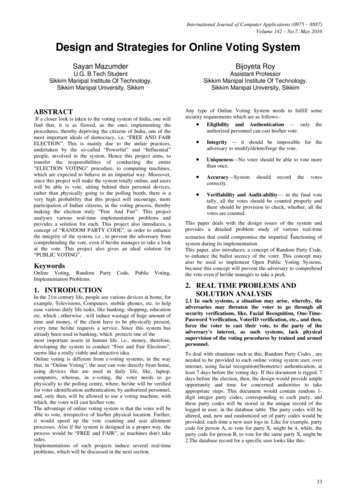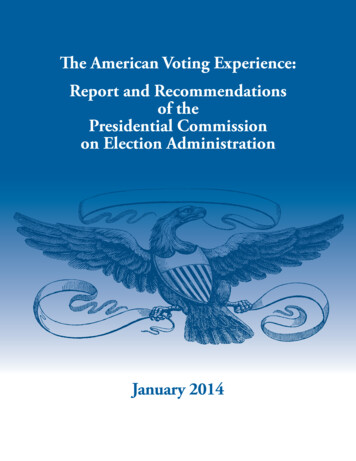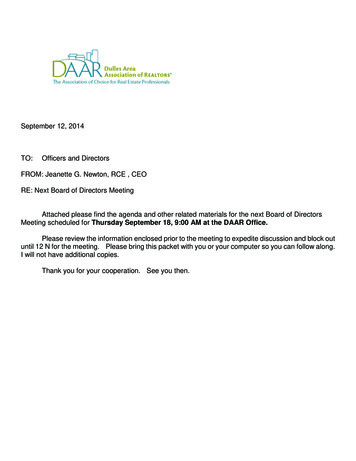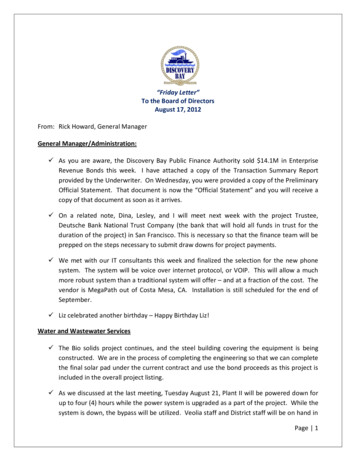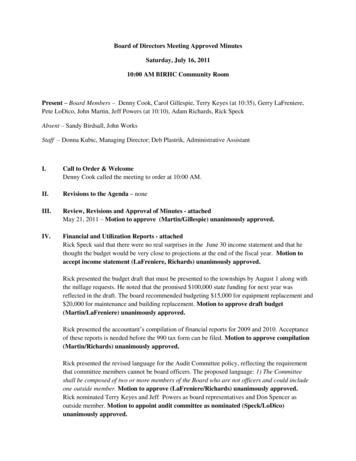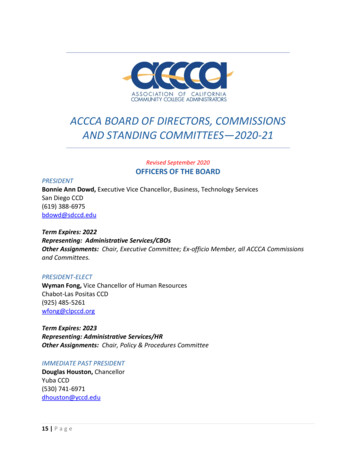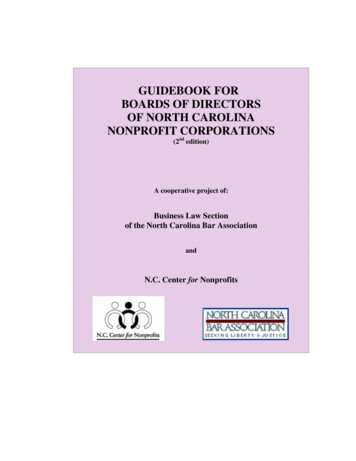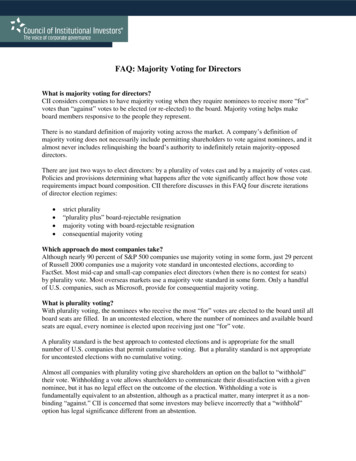
Transcription
FAQ: Majority Voting for DirectorsWhat is majority voting for directors?CII considers companies to have majority voting when they require nominees to receive more “for”votes than “against” votes to be elected (or re-elected) to the board. Majority voting helps makeboard members responsive to the people they represent.There is no standard definition of majority voting across the market. A company’s definition ofmajority voting does not necessarily include permitting shareholders to vote against nominees, and italmost never includes relinquishing the board’s authority to indefinitely retain majority-opposeddirectors.There are just two ways to elect directors: by a plurality of votes cast and by a majority of votes cast.Policies and provisions determining what happens after the vote significantly affect how those voterequirements impact board composition. CII therefore discusses in this FAQ four discrete iterationsof director election regimes: strict plurality“plurality plus” board-rejectable resignationmajority voting with board-rejectable resignationconsequential majority votingWhich approach do most companies take?Although nearly 90 percent of S&P 500 companies use majority voting in some form, just 29 percentof Russell 2000 companies use a majority vote standard in uncontested elections, according toFactSet. Most mid-cap and small-cap companies elect directors (when there is no contest for seats)by plurality vote. Most overseas markets use a majority vote standard in some form. Only a handfulof U.S. companies, such as Microsoft, provide for consequential majority voting.What is plurality voting?With plurality voting, the nominees who receive the most “for” votes are elected to the board until allboard seats are filled. In an uncontested election, where the number of nominees and available boardseats are equal, every nominee is elected upon receiving just one “for” vote.A plurality standard is the best approach to contested elections and is appropriate for the smallnumber of U.S. companies that permit cumulative voting. But a plurality standard is not appropriatefor uncontested elections with no cumulative voting.Almost all companies with plurality voting give shareholders an option on the ballot to “withhold”their vote. Withholding a vote allows shareholders to communicate their dissatisfaction with a givennominee, but it has no legal effect on the outcome of the election. Withholding a vote isfundamentally equivalent to an abstention, although as a practical matter, many interpret it as a nonbinding “against.” CII is concerned that some investors may believe incorrectly that a “withhold”option has legal significance different from an abstention.
Plurality voting in uncontested elections makes directors more accountable to each other than to theshareholders they represent. It’s a “rubber stamp” process that entrenches boards and, in rareinstances, elects directors who lack the confidence of shareholders representing a majority.What is “plurality plus?”In response to growing investor concerns about the lack of accountability inherent in plurality voting,since 2004 some companies have modified their plurality standard, either through non-bindingpolicies or bylaw amendments, to require that a majority-opposed director (for whom “withhold”votes withheld exceed “for” votes) must tender her resignation to the board. However, at “pluralityplus” companies, a nominee who fails to receive majority support is legally elected for another term,subject to board acceptance of the individual’s resignation. Boards in the large majority of caseshave rejected resignations in this situation.CII views plurality plus as a step in the right direction, but not the best way to elect uncontesteddirectors. Plurality plus preserves board control regardless of the voting results. CII encouragesplurality companies to skip “plurality plus” and adopt consequential majority voting.What is majority voting with board-rejectable resignation?With majority voting, uncontested nominees must receive more “for” votes than “against” votes to beelected. Importantly, this standard properly denies majority-opposed nominees the honor of beinglegally elected to the board. However, almost all companies with majority voting couple thatstandard with a resignation requirement for defeated directors. Under the terms of the requirement,the board retains ultimate control over whether the individual departs from the board or stays.This is the form of majority voting found at most S&P 500 companies. Given its widespreadprevalence, CII currently accepts this form of majority voting if the company already has it in place,and the board has a good-faith commitment to replace unelected directors within a reasonable periodof time. Yet the core problem persists; uncontested director elections remain functionally symbolic.CII therefore recognizes consequential majority voting as best practice.Shareholders have other non-binding mechanisms to express their collective views, includingshareholder proposals and non-binding “say-on-pay” votes. Director voting, the basis for boardlegitimacy, should be binding. Plurality-plus and majority vote standards that permit the board toreject a resignation or immediately reappoint the rejected director leave the actual decision on aboard member’s continued service in the hands of the board. In the rare cases in which directors arerejected in uncontested votes, it is not clear that the board, which tends to be put on the defensive byvotes against any of its members, should be trusted to make this decision, except for a reasonableholdover period to arrange for board change.What is consequential majority voting?Consequential majority voting requires an uncontested nominee to receive more “for” votes than“against” votes in order to be elected and establishes a reasonable point at which an unelecteddirector may no longer serve on the board. It is the only approach that places ultimate authority in thehands of the company’s owners. In this regard, it is the only approach with “teeth.”2
Some investors oppose this approach because in certain situations, shareholders oppose directorsbased on a policy matter, and in the view of these investors it is acceptable for the individual tocontinue on the board if the policy matter is resolved or meaningfully addressed. In some cases, thiseven extends to the director’s behavior. For example, some incumbent directors are rejected due topoor attendance at board meetings, and shareholders can be amenable to their continued service witha pledge by the individual to improve attendance.For sample bylaw language providing for consequential majority voting, please refer to Appendix 1,which provides both a Delaware-compliant example and a Model Business Corporation Act (MBCA)version.Does a majority standard (whether traditional or “consequential”) create the potential for anabrupt board vacancy upon a director’s defeat?In order to be workable, any majority vote requirement must be coupled with some form of“holdover” provision ensuring reasonable accommodation for a smooth transition in the event of adirector's defeat. The purpose of a holdover provision is twofold: to safeguard against a hastyrecruitment process for a suitable replacement, and to maintain compliance with the company’sgoverning documents, contractual agreements, exchange listing standards and regulatoryrequirements throughout the transition period. Holdover provisions typically allow 90 days for thetransition, and CII believes a window of up to 180 days is reasonable in certain circumstances.Is consequential majority voting permissible under state law?Yes. Section 141 of Delaware General Corporation Law provides that each director shall hold officeuntil such director’s successor is elected and qualified or until such director’s earlier resignation. A2006 amendment to Section 141 clarified that “a resignation is effective when the resignation isdelivered unless the resignation specifies a later effective date or an effective date determined uponthe happening of an event or events [including failure to obtain a majority of votes cast]. Aresignation which is conditioned upon the director failing to receive a specified vote for reelection asa director may provide that it is irrevocable.”Although many Delaware companies since 2006 have amended their bylaws to adopt a majority votestandard and a resignation requirement for directors who fail to obtain a majority of votes cast, thesebylaws generally preserve the board’s discretion to reject the resignation letter and keep the directoron the board indefinitely.Consequential majority voting is also permitted under the MBCA. In states where corporate law isbased on the MBCA, mandatory departure of an unelected director can be tied to a fixed number ofdays following the election, unlike in Delaware where departure must be tied to a resignation.Is there evidence that shareholders care about this issue?Yes. According to FactSet, the 89 management proposals from 2013- 2016 for a majority votestandard received average support of 98 percent of shares voted (and 79 percent of sharesoutstanding). In each year since 2007, average support for shareholder proposals requesting majorityvoting exceeded 50 percent. Since that year, average annual support has grown from 50.4 percent ofvotes cast “for” and “against” to 73 percent in 2016. Most of these shareholder proposals wereopposed by management.3
Would there be significant director turnover if every company had to replace majorityopposed directors?No. A tiny fraction of uncontested director elections result in failure to obtain majority support. In2016, just 47 uncontested directors in the entire Russell 3000 did not receive majority support. Thesefailures affected only 28 companies, or less than 1 percent of the index.Is there any evidence that having majority voting in place makes a difference in actual directorturnover when directors fail to obtain majority support?Yes. Based on uncontested elections from 2013-2016 in which at least one director did not receivemajority support, the vote requirement matters. Overall, a rejected uncontested director left the board25 percent of the time. At “plurality plus” companies, the departure rate was nearly the same—24percent, as of the close of 2016.By contrast, at companies with majority voting, seven of nine directors who lost elections in the sameperiod permanently left the board. The numbers involved are small but encouraging. Of course, anymajority-opposed director at a company with consequential majority voting would have a 100percent departure rate for unelected directors.More details can be found on CII’s website. These findings are generally consistent with a 2012study by the IRRC Institute and GMI Ratings, which found that “companies with majority standardsare more likely than others to remove directors who receive minority support.”Why do so few companies have consequential majority voting?Many boards view themselves as best qualified to make final decisions about the fate of majorityopposed directors, discounting shareholder views. Skeptics of consequential majority voting mayargue that requiring an unelected director to leave the board could cause the company to be out ofcompliance with contracts, listing standards or corporate governing documents. (In fact,consequential majority voting provides a grace period to maintain compliance.) Skeptics may alsoclaim that consequential majority voting empowers “special interests.” (This argument strikes CII asweak on its face, as holders of a majority of shares voting – the threshold for failure of a nomineeunder consequential majority vote standard – should not be considered a “special interest” in thecontext of a widely held public company with one-share, one-vote.)Additionally, statutory and regulatory history bends toward plurality voting. Most states havecorporate codes establishing plurality voting as the default standard, and companies are inclined tofollow the default. Although some states have made majority voting the default, no state requiresmajority voting in uncontested director elections. CII petitioned the Delaware State Bar Associationand the American Bar Association (ABA) to embrace majority voting, first as a default, then as auniversal standard for publicly-traded companies. The Delaware bar and the ABA declined tosupport the proposals. The major U.S. stock exchanges do not require listed companies to electdirectors by majority vote, despite CII requests to amend listing standards subject to SEC approval.(Correspondence with the Delaware bar, the ABA and the exchanges can be found here.)Isn’t the threat of a proxy fight from activist shareholders sufficient to hold boards accountableto shareholders, without any need for shareholders to have an option to vote against directorsin routine, uncontested elections?4
No. Even in uncontested situations, the election of directors should be more than an empty formality.Director elections are the basis for legitimacy of boards of directors in their exercise of power overproperty they do not own.It is true that proxy fights for board seats are a critical accountability mechanism, but such fightsentail substantial cost, are often disruptive and in some cases can focus on financial engineering forthe benefit of short-term shareholders. Directors should be accountable to all shareholders on a moreroutine basis. In addition to the traditional proxy fight, many companies now permit large long-termholders to use “proxy access” to nominate a small minority of directors. However, we believe thatvoting rights should be meaningful without a requirement for a dissident nomination process andescalation to a proxy fight, even including a tool like proxy access that empowers only long-termshareholders. Moreover, proxy access has not been mandated market-wide.Does the SEC regulate how companies describe their voting standards in SEC
resignation which is conditioned upon the director failing to receive a specified vote for reelection as a director may provide that it is irrevocable.” Although many Delaware companies since 2006 have amended their bylaws to adopt a majority vote standard and a resignation requirement for directors who fail to obtain a majority of votes cast, these bylaws generally preserve the board’s .
